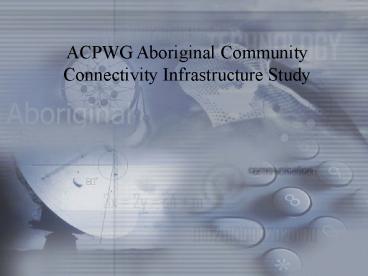ACPWG Aboriginal Community Connectivity Infrastructure Study - PowerPoint PPT Presentation
1 / 14
Title:
ACPWG Aboriginal Community Connectivity Infrastructure Study
Description:
Year to year trend analysis. This is a follow up to the 2002 connectivity report ... of Aboriginal communities with HS vs. all Canadian communities moderate ... – PowerPoint PPT presentation
Number of Views:34
Avg rating:3.0/5.0
Title: ACPWG Aboriginal Community Connectivity Infrastructure Study
1
ACPWG Aboriginal Community Connectivity
Infrastructure Study
2
Aboriginal Community Connectivity Infrastructure
- Purpose
- Verify the existence of, then track trends of
the Aboriginal digital divide
- Important to aggregate all connectivity
initiatives to present the most accurate picture
to policy makers
- Provide a source of information for communities
that are struggling to get online
- Address the need to track trends in connectivity
rather than capture a snapshot Internet
connectivity rates are a moving target.
- Create a coordinated centre to deal with the
difficulties of analyzing connectivity in
Aboriginal communities - Population, counting, geographic challenges
- Seasonal populations
- Community definitions
3
Difficulties Faced when collecting Information
- Community Definitions
A locality which is considered to be an Indian,
Inuit or Métis community (Indian reserve, Indian
settlement, Métis settlement, Inuit hamlet or
census sub-division with 25 percent or more
aboriginal population) having the following
attributes a name, distinct physical location
and territory, and aboriginal governance
structure, mandate and constituency
- Not all Band or community administration offices
are on reserve
- Survey Fatigue
- Connectivity status changes quicker than our
survey turnaround
- Change in community administrative personnel
- How do you assess the degree of connectivity for
urban Aboriginals
4
2003 Report - Building on 2002
- This is a follow up to the 2002 connectivity
report
- Moved away from defining a community with
dial-in (long distance) - access as connected
- Beginning to track urban connectivity
- Attempt made at qualifying the digital divide
- Further analysis of connectivity rates based
upon degree of remoteness
- Year to year trend analysis
5
General Findings
Community Access
6
General Findings
Community Access
- Northern communities are better connected to
high speed services but less connected overall
7
General Findings
Community Access
- Northern communities are better connected to
high speed services but less connected overall
- Remote Aboriginal communities (north 55, 50 KM
from service centre, no year round road access)
are not surprisingly, poorly connected
8
General Findings
Household Access
- Connectivity rates at the household are slightly
below that of the general community
- Community members are slow to subscribe to
Internet services
What percentage of community residents currently
subscribe to an ISP service?
9
Comparing 2003 to 2002
- High Speed access rates have increased
- So has the percentage of totally disconnected
communities
10
A Digital Divide?
Many different ways to look at existence
- On reserve Aboriginal population vs. rest of
Canada - Digital Divide exists (25 vs. 75).
11
A Digital Divide?
Many different ways to look at existence
- Percentage of Aboriginal communities with HS vs.
all Canadian communities moderate digital
divide (21 vs. 24)
12
A Digital Divide?
Many different ways to look at existence
- Northern Aboriginal communities vs. all Canadian
communities a digital divide exists on basic
access (46 vs. 28) but not high speed (26 vs.
24)
13
A Digital Divide?
Many different ways to look at existence
- Remote Aboriginal communities vs. all Canadian
communities a strong digital divide exists for
both HS access (15 vs. 24), and basic access
(43 vs. 28)
14
Next Steps
- Collect feedback (until January 24) on draft
report and implement recommendations - mailto
connectivity_at_inac.gc.ca or contact me directly
- Publish statistics, graphs, .pdf report to the
connectivity section of Portal
- Complete mapping of Aboriginal communities with
links to detailed - connectivity statistics
- Distribute report to Aboriginal communities
- Begin work on 2004 statistics

